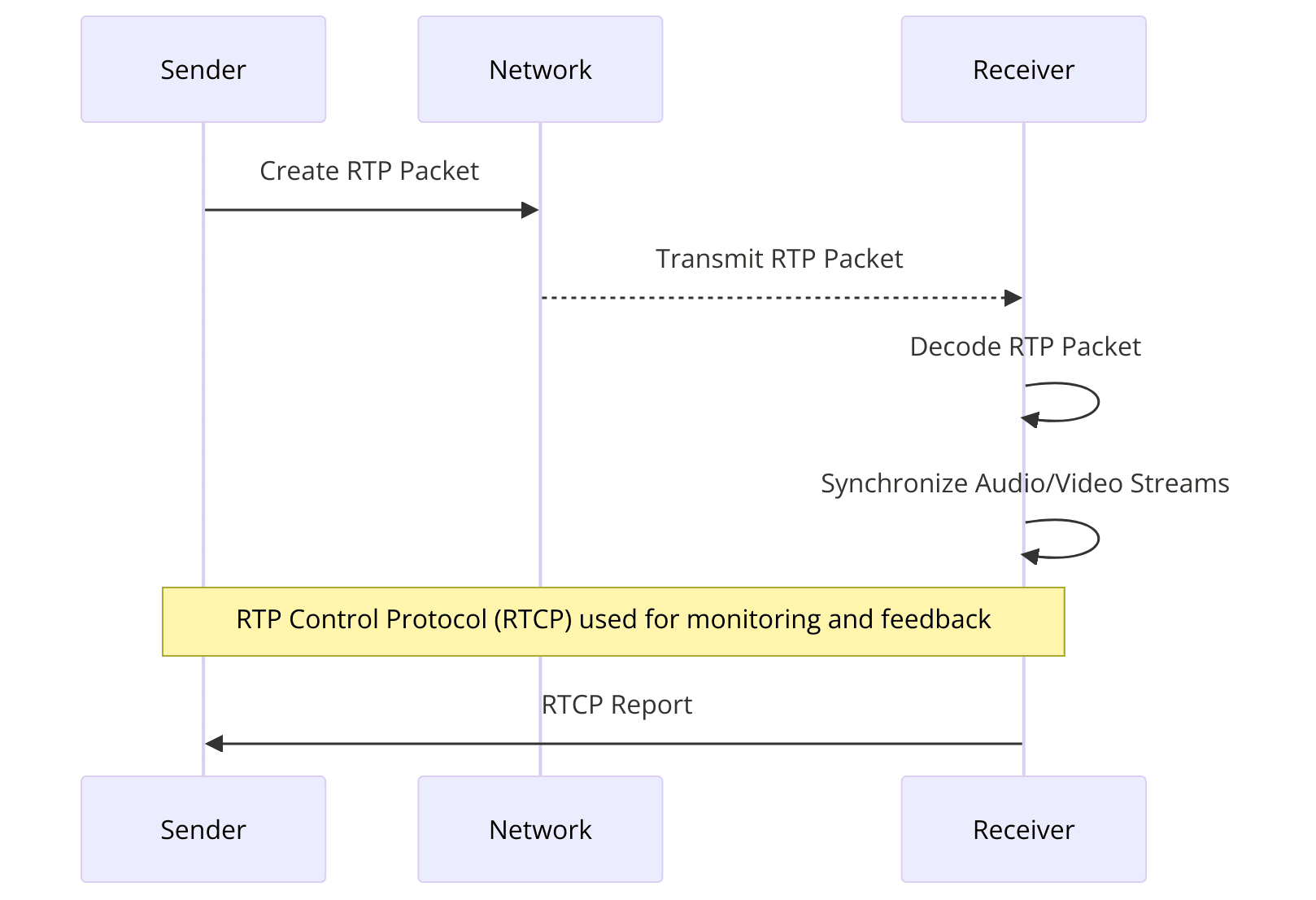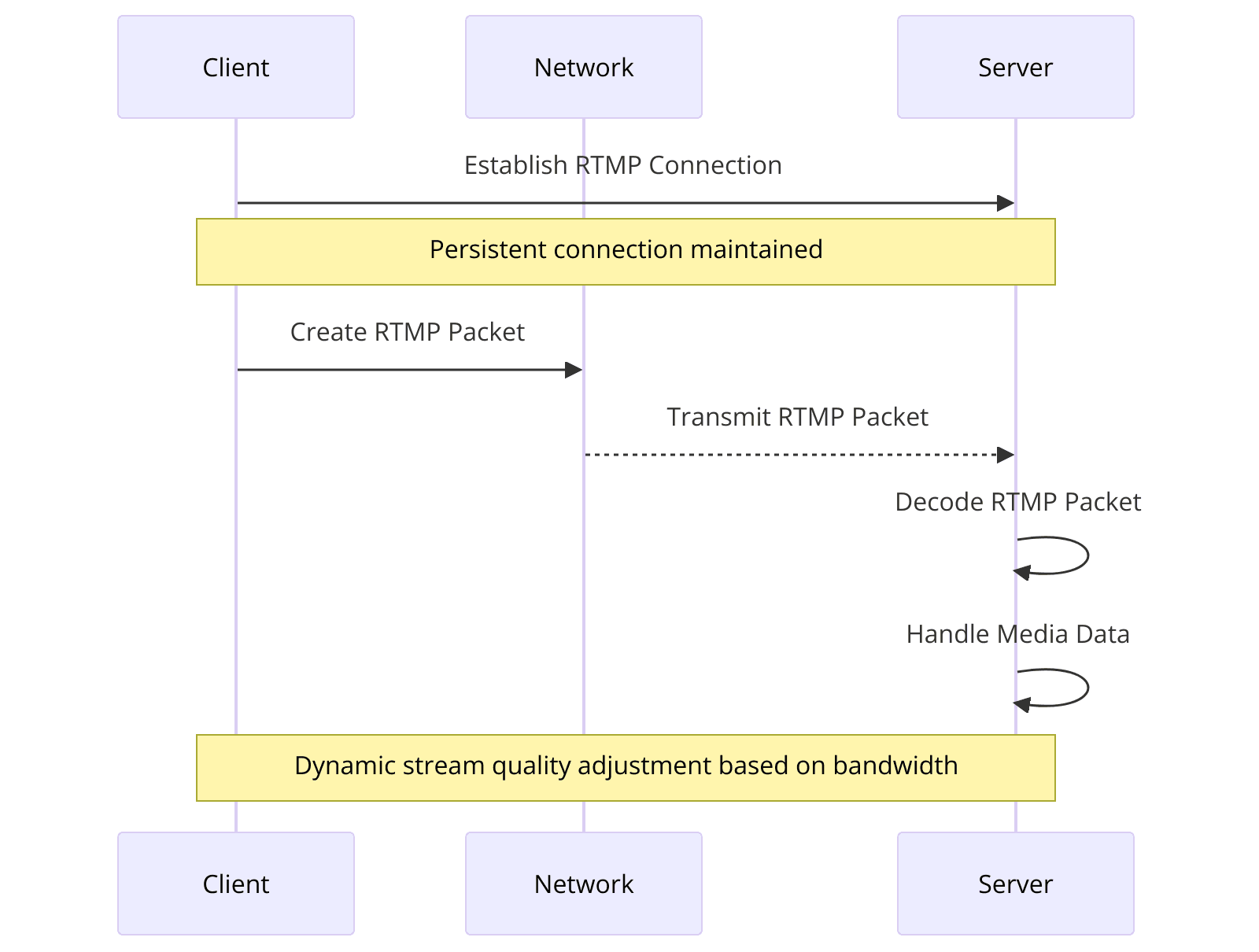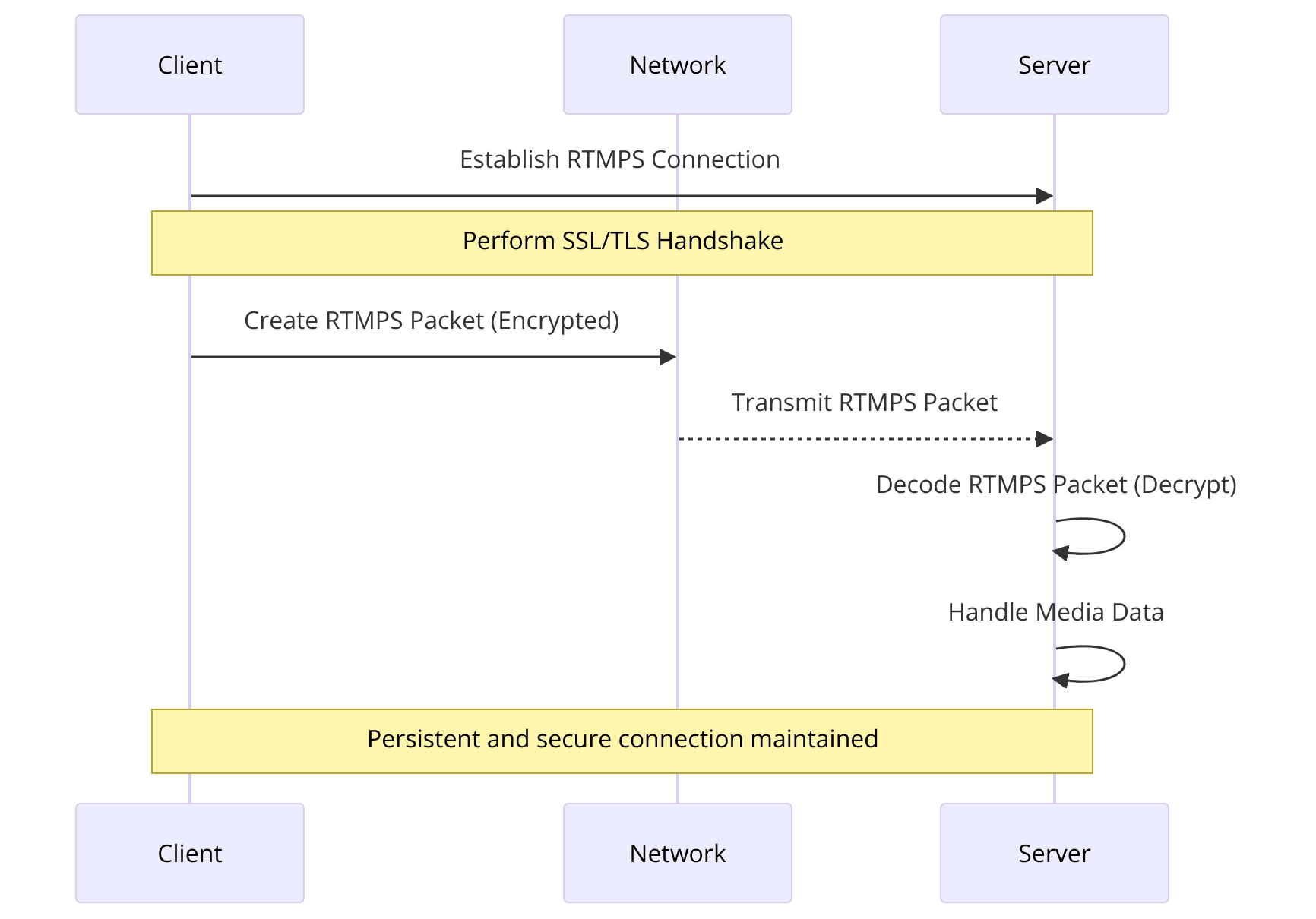Introduction of RTP vs RTMP vs RTMPS
As we know that in the digital communication, streaming protocols play a crucial role in delivering real-time audio and video content. Among the many streaming protocols available, RTP, RTMP, and RTMPS stand out for their widespread use and unique features. These protocols facilitate the seamless transmission of media data over the internet, ensuring users receive high-quality streams with minimal latency.
Understanding the differences of RTMP/RTMPs vs RTP is essential for anyone involved in streaming media. This article describe each protocol, comparing their features, use cases, and performance to help you make informed decisions for your streaming needs.
What is RTP(Real-Time Transport Protocol)?
Real-Time Transport Protocol
(RTP) is a network protocol designed for delivering audio and video over IP networks. Introduced in 1996, RTP has become the backbone of many real-time communication systems, including telephony, video conferencing, and live broadcasting.How RTP(Real-Time Transport Protocol) works?
RTP operates on the transport layer, typically using UDP (
User Datagram Protocol
) to minimize latency. It is designed to handle the timing issues and data packet loss that can occur in real-time communication. Key features of RTP include timestamping, sequence numbering, and payload identification, which ensure that media streams are synchronized and delivered in the correct order.
One of the significant advantages of RTP is its ability to provide real-time delivery of multimedia data. This makes it ideal for applications where timing is critical, such as
VoIP
and video conferencing. Additionally, RTP is often used in conjunction with RTCP (RTP Control Protocol), which monitors data delivery and provides feedback on the quality of the service.RTP's versatility extends to various applications, from RTP streaming live sports events to enabling interactive video chat applications. Its robustness in handling real-time data and ensuring high-quality media delivery has cemented its place in modern communication systems.
What is RTMP(Real-Time Messaging Protocol)?
Real-Time Messaging Protocol
(RTMP) was developed by Macromedia, which was later acquired by Adobe, to enable high-performance transmission of audio, video, and data between a server and a Flash player. RTMP became the standard for live streaming and on-demand media due to its low latency and ability to maintain persistent connections.How RTMP(Real-Time Messaging Protocol) works?
RTMP works by breaking the data into smaller packets and transmitting them over a single persistent connection. This approach ensures that the data is delivered with minimal delay, which is crucial for live streaming applications. One of RTMP's key features is its ability to dynamically adjust the stream quality based on the viewer's bandwidth, providing a smooth viewing experience even on fluctuating internet connections.

RTMP's widespread adoption is evident in its use by major streaming platforms such as YouTube, Facebook Live, and Twitch. The protocol's flexibility and efficiency have made it a favorite for live broadcasters who require reliable and low-latency streams.
Despite its popularity, RTMP has seen a decline in use with the advent of newer protocols like HLS
(HTTP Live Streaming)
and MPEG-DASH, which offer better compatibility with HTML5 and mobile devices. However, RTMP remains a critical part of the streaming ecosystem, particularly for live event streaming where low latency is paramount.What is RTMPS?
Secure Real-Time Messaging Protocol (RTMPS) is an extension of RTMP that incorporates SSL/TLS encryption to enhance the security of data transmission. Developed to address the growing need for secure streaming, RTMPS ensures that the media content remains protected from eavesdropping and tampering during transmission.
How RTMPS works?
RTMPS operates similarly to RTMP, maintaining the same low latency and persistent connection benefits. However, by encrypting the data stream, RTMPS provides an added layer of security, making it suitable for applications where data privacy is crucial. This includes corporate communications, secure live event broadcasts, and any scenario where sensitive information is being transmitted.

One of the main advantages of RTMPS is its ability to secure data without significantly impacting performance. The encryption process is efficient, ensuring that streams remain smooth and uninterrupted. This balance between security and performance has made RTMPS a preferred choice for many organizations looking to protect their streaming content.
Implementing RTMPS involves configuring an RTMP server to use SSL/TLS certificates, a process that is straightforward and well-documented. This ease of implementation, combined with its robust security features, has driven the adoption of RTMPS in various streaming applications.
RTP vs RTMP vs RTMPS : Key Differences
Real-Time Transport Protocol (RTP) and Real-Time Messaging Protocol (RTMP) inlcuding RTMPS are both essential for streaming media, but they serve different purposes and operate under distinct paradigms. Understanding these differences can help in choosing the right protocol for your streaming needs.
RTP is designed primarily for real-time communication such as VoIP and video conferencing. It operates over UDP, focusing on minimal latency and the timely delivery of media packets. RTP's strengths lie in its ability to handle time-sensitive data and ensure synchronized audio and video streams. It’s widely used in scenarios where immediate data delivery is crucial, such as live interactive applications.
RTMP, while efficient and widely used for live streaming, transmits data in plain text, making it vulnerable to eavesdropping and tampering. This is where RTMPS comes into play, leveraging SSL/TLS encryption to secure the data stream. By encrypting the data, RTMPS protects against interception and ensures that sensitive information remains confidential.
As RTP focuses on performance and real-time data delivery, RTMPS prioritizes security without significantly compromising on performance. The encryption process in RTMPS is designed to be efficient, maintaining smooth and uninterrupted streams. This balance of security and performance makes RTMPS suitable for secure streaming needs, where protecting data is as important as delivering it effectively.
Choosing the Right Protocol for Your Needs
Selecting the appropriate streaming protocol—RTP, RTMP, or RTMPS—depends on various factors including security, latency, and compatibility with your specific use case. Understanding these factors can help you make an informed decision.
Security:
If your streaming application requires high security, RTMPS is the clear choice. RTMPS encrypts data during transmission, protecting it from unauthorized access and ensuring compliance with privacy regulations. This makes it ideal for corporate communications, secure live events, and healthcare applications where data privacy is paramount.
Latency:
For applications demanding minimal latency, such as real-time communications and interactive sessions, RTP is the best option. RTP is designed to deliver audio and video with minimal delay, making it suitable for video conferencing, VoIP, and live interactive broadcasts. Its ability to synchronize streams ensures high-quality real-time communication.
Compatibility: RTMP remains a popular choice for live streaming due to its compatibility with major streaming platforms like YouTube, Facebook Live, and Twitch. RTMP’s persistent connection ensures smooth and continuous streaming, making it a reliable choice for live broadcasts. Additionally, RTMP’s ability to dynamically adjust stream quality based on bandwidth conditions ensures a consistent viewing experience.
A Step-by-Step Guides of Implemention RTP, RTMP, & RTMPS
RTP Implementation
Implementing Real-Time Transport Protocol (RTP) involves setting up a system to efficiently deliver real-time audio and video over IP networks. Here’s a step-by-step guide to get you started with RTP.
Step 1 : Setup Your Environment
Ensure you have a compatible environment. RTP can be implemented in various programming languages, but C/C++ and Python are commonly used. For this guide, we’ll use Python.
Step 2: Install Required Libraries
Install the necessary libraries. For Python,
pyrtp is a useful library.bash
1 pip install pyrtpStep 3: Create RTP Packets
Begin by creating RTP packets. These packets will contain the media data you want to transmit.
Python
1 from pyrtp import RTPPacket
2
3 packet = RTPPacket(payload_type=0, sequence_number=1, timestamp=12345, ssrc=67890)
4 packet.payload = b'\x80\x78\x56\x34\x12' # Example payloadStep 4: Transmit RTP Packets
Set up a socket to transmit these packets over the network.
Python
1 import socket
2
3 sock = socket.socket(socket.AF_INET, socket.SOCK_DGRAM)
4 sock.sendto(packet.encode(), ('192.168.1.100', 5004)) # Replace with your IP and portStep 5: Receive RTP Packets
On the receiving end, you need a socket to capture the incoming RTP packets.
Python
1 import socket
2
3 sock = socket.socket(socket.AF_INET, socket.SOCK_DGRAM)
4 sock.bind(('0.0.0.0', 5004))
5
6 while True:
7 data, addr = sock.recvfrom(2048)
8 packet = RTPPacket.decode(data)
9 print(f'Received packet from {addr} with payload: {packet.payload}')Step 6 : Synchronize Streams
Use RTP Control Protocol (RTCP) to monitor and manage data delivery, ensuring synchronization and quality.
Python
1 from pyrtp import RTCPPacket
2
3 rtcp_packet = RTCPPacket(sender_ssrc=67890, fraction_lost=0, cumulative_lost=0, highest_seq_num=1, interarrival_jitter=0, last_sr=12345, delay_since_last_sr=0)
4 sock.sendto(rtcp_packet.encode(), ('192.168.1.100', 5005)) # RTCP runs on a different portBy following these steps, you can successfully implement RTP to stream real-time audio and video. Adjust the IP addresses and ports according to your network setup.
RTMP Implementation
Implementing Real-Time Messaging Protocol (RTMP) involves setting up a server and configuring it to stream audio and video content. Here’s a detailed guide to help you get started with RTMP.
Step 1: Setup Your RTMP Server
Use a popular RTMP server like Nginx with the RTMP module. Install Nginx and the RTMP module.
bash
1 sudo apt-get install nginx libnginx-mod-rtmpStep 2 : Configure the RTMP Module
Edit the Nginx configuration file to include RTMP settings.
nginx
1 rtmp {
2 server {
3 listen 1935;
4 chunk_size 4096;
5
6 application live {
7 live on;
8 record off;
9 }
10 }
11 }
12
13 http {
14 server {
15 listen 8080;
16
17 location / {
18 root /var/www/html;
19 index index.html index.htm;
20 }
21
22 location /stat {
23 rtmp_stat all;
24 rtmp_stat_stylesheet stat.xsl;
25 }
26
27 location /stat.xsl {
28 root /usr/share/nginx/html;
29 }
30 }
31 }Step 3 : Restart Nginx
Apply the configuration changes by restarting Nginx.
bash
1 sudo systemctl restart nginxStep 4 : Stream to Your RTMP Server
Use a streaming software like OBS Studio to stream to your RTMP server. In OBS, set the stream URL to
rtmp://your_server_ip/live and choose a stream key.Step 5 : Receive and Play the Stream
Use an RTMP-compatible player to receive and play the stream. VLC Media Player can play RTMP streams; open VLC and use
rtmp://your_server_ip/live/your_stream_key to start watching.Step 6 : Monitor the Stream
Access the RTMP statistics by navigating to
http://your_server_ip:8080/stat to monitor the health and status of your streams.By following these steps, you can set up and run an RTMP server, enabling you to stream live video content efficiently.
RTMPS Implementation
Implementing Real-Time Messaging Protocol Secure (RTMPS) involves adding SSL/TLS encryption to your RTMP stream to ensure secure data transmission. Here’s how to implement RTMPS:
Step 1: Setup Your RTMP Server with SSL/TLS
Install Nginx with the RTMP module and ensure you have OpenSSL installed.
bash
1 sudo apt-get install nginx libnginx-mod-rtmp opensslStep 2: Generate SSL Certificates
Generate a self-signed SSL certificate or use a certificate from a Certificate Authority.
bash
1 openssl req -x509 -newkey rsa:2048 -keyout key.pem -out cert.pem -days 365 -nodesStep 3: Configure Nginx for RTMPS
Edit the Nginx configuration file to include SSL settings for RTMPS.
nginx
1 rtmp {
2 server {
3 listen 1935 ssl;
4 chunk_size 4096;
5
6 ssl_certificate /etc/nginx/cert.pem;
7 ssl_certificate_key /etc/nginx/key.pem;
8
9 application live {
10 live on;
11 record off;
12 }
13 }
14 }
15
16 http {
17 server {
18 listen 8080;
19
20 location / {
21 root /var/www/html;
22 index index.html index.htm;
23 }
24
25 location /stat {
26 rtmp_stat all;
27 rtmp_stat_stylesheet stat.xsl;
28 }
29
30 location /stat.xsl {
31 root /usr/share/nginx/html;
32 }
33 }
34 }Step 4: Restart Nginx
Apply the configuration changes by restarting Nginx.
bash
1 sudo systemctl restart nginxStep 5: Stream to Your RTMPS Server
Use OBS Studio or another streaming software to stream to your RTMPS server. Set the stream URL to
rtmps://your_server_ip/live and use a stream key.Step 6: Receive and Play the Stream
Use an RTMPS-compatible player to receive and play the stream. VLC Media Player can play RTMPS streams; open VLC and use
rtmps://your_server_ip/live/your_stream_key to start watching.Step 7: Monitor the Stream
Check the RTMP statistics at
http://your_server_ip:8080/stat to monitor the health and status of your RTMPS streams.By following these steps, you can implement RTMPS to secure your streaming content, ensuring data protection and privacy during transmission.
Advanced Applications and Use Cases
RTP Use Cases
Real-Time Transport Protocol (RTP) excels in scenarios requiring precise timing and minimal latency, making it indispensable in various advanced applications. One of the most prominent use cases for RTP is in professional broadcasting. Television networks and live sports broadcasters rely on RTP for its ability to deliver high-quality, synchronized audio and video streams with minimal delay, ensuring viewers receive a seamless viewing experience.
Another critical application of RTP is in real-time communications, such as Voice over IP (VoIP) and video conferencing. RTP's capability to handle packet loss and maintain stream quality is crucial in these settings, where uninterrupted and clear communication is essential. Educational institutions and corporate environments increasingly use RTP for virtual classrooms and remote meetings, leveraging its low-latency properties to facilitate real-time interaction.
RTMP Use Cases
Real-Time Messaging Protocol (RTMP) remains a cornerstone of live streaming platforms, particularly in delivering interactive and low-latency streams. One of the most notable applications of RTMP is in live streaming services such as YouTube Live, Facebook Live, and Twitch.
In addition to live streaming, RTMP is widely used in interactive media applications. Online gaming platforms, for instance, utilize RTMP to stream live gameplay, enabling gamers to share their experiences with audiences worldwide in real-time. The protocol's ability to maintain a stable connection and adjust stream quality dynamically based on network conditions ensures a consistent viewing experience.
Another advanced use case for RTMP is in the realm of online education. Educational institutions and e-learning platforms employ RTMP to stream live lectures and interactive sessions, providing students with a virtual classroom experience.
RTMPS Use Cases
One of the primary use cases for RTMPS is in secure corporate communications. RTMPS is widely used in secure live event streaming. Events such as shareholder meetings, product launches, and webinars often require a secure streaming solution to prevent data breaches and ensure that only authorized viewers can access the content.
RTMPS is also crucial in healthcare applications, particularly in telemedicine and remote patient monitoring. The protocol ensures that medical consultations, diagnostic procedures, and patient data transmissions remain confidential and secure, adhering to stringent privacy regulations such as HIPAA. This secure communication channel enables healthcare providers to deliver remote services effectively, ensuring patient data is protected.
Conclusion
The landscape of streaming protocols is continually evolving, driven by advancements in technology and changing user demands. Understanding future trends can help you stay ahead in the streaming industry.
Emerging Protocols
Newer protocols like
WebRTC
(Web Real-Time Communication) are gaining traction for their ability to facilitate peer-to-peer communication without requiring plugins. WebRTC offers real-time, low-latency communication and is being increasingly adopted for video conferencing, online gaming, and interactive live streaming.Enhanced Security
As cybersecurity threats continue to rise, the demand for secure streaming solutions will grow. Protocols like RTMPS will see wider adoption, and new security enhancements will be integrated into existing protocols to ensure data protection. This trend is particularly relevant for industries handling sensitive information, such as finance and healthcare.
Improved Quality of Service (QoS)
Advances in AI and machine learning are expected to enhance QoS in streaming. These technologies can dynamically adjust streaming parameters based on real-time network conditions, ensuring optimal performance and minimal buffering. This will improve the viewing experience across various devices and network environments.
Increased Adoption of Adaptive Streaming
Protocols like HLS (HTTP Live Streaming) and MPEG-DASH, which offer adaptive bitrate streaming, will continue to gain popularity. These protocols automatically adjust the video quality based on the viewer’s bandwidth, providing a smoother experience, especially on mobile devices.
Want to level-up your learning? Subscribe now
Subscribe to our newsletter for more tech based insights
FAQ